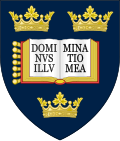This article has multiple issues. Please help improve it or discuss these issues on the talk page . (Learn how and when to remove these messages)
|
 The department seen from South Parks Road | |
| Established | 1888 (School of Geology) |
|---|---|
| Affiliation | University of Oxford |
| Head of Department | Chris Ballentine |
| Undergraduates | c. 120 |
| Postgraduates | c. 80 |
| Location | , 51°45′31″N1°15′16″W / 51.7586°N 1.2544°W |
| Website | earth |
 | |
The Department of Earth Sciences is the Earth sciences department of the University of Oxford, England, which is part of the university's Mathematical, Physical and Life Sciences Division. The department is based in the Earth Sciences building on South Parks Road in the Science Area.
